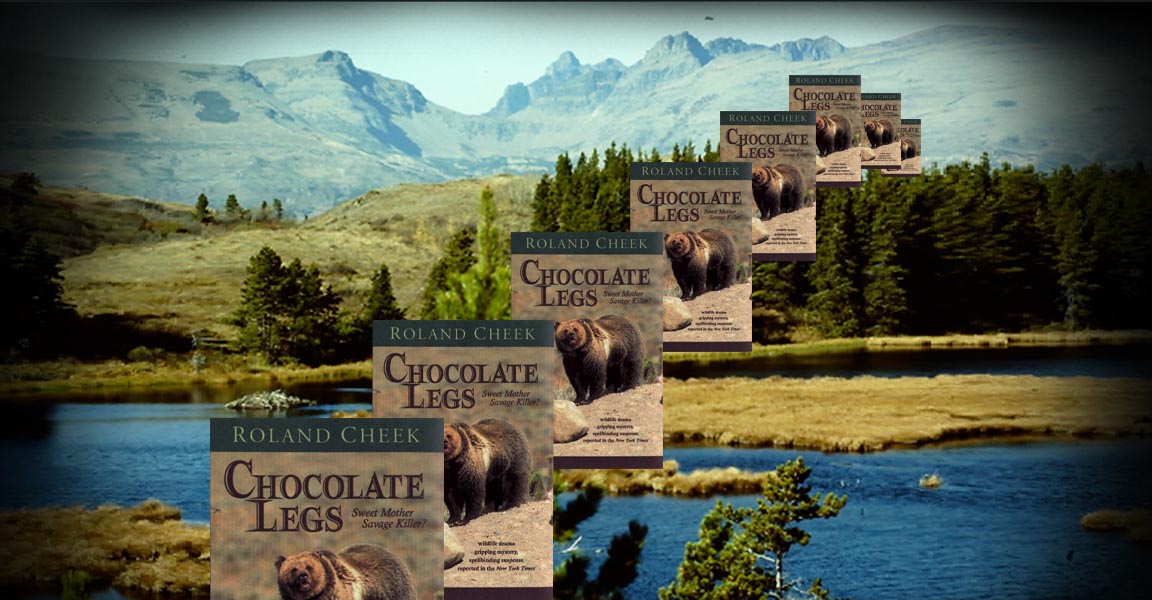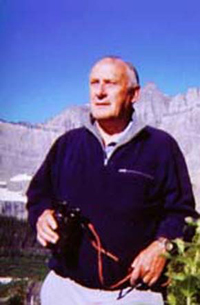


She was called "cute," "friendly," "beautiful." Also, "pushy," "disdainful," "arrogant." In time, the blonde bombshell was viewed as "dark," "furtive, "dangerous." And finally she was condemned as "skulking," "underhanded," and "murdering."
But was she?
Or was she, in the grizzly bear world, a good mother?
what people are saying:
A self-made naturalist, Cheek has a thing about grizzly bears that some people feel defies understanding. Readers can thrill to a mesmerizing tale of grizzly bears and humans who, in chilling detail, morph into a lethal mix. . . - Outdoors Unlimited / publication of Outdoor Writers Asso. of America
I was in Glacier last year and purchased Chocolate Legs. I am an avid reader and have been reading my whole life. I can honestly say that this is my favorite book of all time. I am currently reading Learning to Talk Bear and am enjoying it as well. I am a nature photographer in National Parks and have always enjoyed taking photos of big game. I haven't done any grizzlies yet, but that is one of my goals. Your books are helping me to understand how important respecting the bears is and keeping a very safe distance... - email from Jim Lee
Chocolate Legs is a story of triumph and tragedy. - Tom Lawrence / Whtefish Pilot
Roland Cheek is at his best when he's describing bears in action. And at his best, he's excellent! - Bob Mottram / Outdoors Editor for Tacoma's The News Tribune
Chocolate Legs is a superb book capturing the essence of a single wild animal. It will reside on my bookshelf alongside the best of Will James or Farley Mowat. - Duncan LaSade / Missoula, MT
I worry about the bear Chocolate Legs and her cubs. How unfortunate a life was lost. She made a mistake and it sounds like her penalty is death. - Lucille Gunderski /Markesan, WI
More Reviews
by
Lois Lonnquist Book Coordinator
. . . Cheek researched the story of Chocolate legs from the time she first came to the attention of biologists early in her life as a "roadside bum, begging snacks from tourists visiting the specatcular Many Glacier Valley.
This interaction with humans led to her being tagged and taken by helicopter to a remote area of the park.
The author follows her through the next ten years of her life using information supplied by her radio collar, reported sightings, and his "dead-reckoning based on a lifetime of experiences with grizzlies."
He tells of her fearless visits to campsites, her fiercely protective mothering, and her fight for survival among her own kind. Events that led to the end of her life are recorded in official journals and the many news stories that appeared in media worldwide.
"Chocolate Legs" is a fascinating book, well researched and well written. Outdoorsperson or not, you are drawn into the story and left with your own questions. This ccount of the life and death of Chocolate Legs sheds light on the controversy and ongoing efforts of wildlife specialists to find a place in the wilds for both man and bear.
"Chocolate Legs," is the true story of three bears--a mother grizzly, a "beautiful blond with Chocolate colored legs," and her two look-alikes, the youngest of her several cubs.
They lived in the wild in Glacier National Park. But unlike the other story of the three bears their story does not end with everyone living happily ever after.
In May 1998, an experienced outdoorsman, 26-year-old Craig Dahl, who was hiking in Glacier National Park, was apparently mauled to death by a bear and his body consumed.
The believed killer was methodically tracked down and killed. But, was there more to the story?
Author and former wilderness guide Roland Cheek believes there might have been and he is haunted by his own question, "Was Chocolate Legs the marauding killer we humans believe?"
In his quest to find an answer, Cheek researched the story of Chocolate Legs from the time she first came to the attention of biologists early in her life as a "roadside bum, begging snacks from toursts visiting the spectacular Many Glacier Valley."
Cheek was a mountain guide in the Northern Rockies for more than 20 years. He has written a syndicated column for the past 20 years, along with hundreds of magazine articles. He hosted a popular national radio show for seven years. He and his wife Jane, the marketing director of Skyline Publishing, live near Columbia Falls.
He is the author of five other books: "My Best Work Is Done at the Office," "Learning To Talk Bear," "Phantom Ghost of Harriet Lou," "Dance on the Wild Side," and "Montana's Bob Marshall Wilderness." Books are available at local bookstores or can be purchased from Skyline Publishing through Roland's website at www.rolandcheek.com
Vol. 48, No. 11
by
Mack McConnell
Roland Cheek, the award-winning author of "Learning to Talk Bear," has turned out another masterpiece sure to enthrall bear lovers and bear haters alike, along with just about anyone interested in nature. "Chocolate Legs" is a story of triumph and tragedy. It is a murder mystery and a biography of one of the most notorious grizzly bears ever to wander Glacier National Park.
From timid cub to brazen adulthood, Cheek tells the tale of the life of an extraordinary bruin. Chocolate Legs wore radio collars much of her life so there is some documentation of her travels and her interaction with humans. But Cheek has taken literary license to put a personal and artistic touch to the story. In the wonderful, descriptive way Cheek aficionados have come to expect, he brings the bears and other wilderness denizens to life in the reader's imagination.
The book is not a documentary. Neither is it a novel. Cheek has simply filled in the blanks with plausible story lines. The animals and events he describes arise from knowledge gained during a life in the mountains observing nature in general, but with concentration on elk and bears.
Cheek neither sensationalizes nor sugar coats. He tells real-life stories in real-life terms. The reader will come away with a wealth of knowledge about bears and their surroundings even if that is not his or her intent. With intricate and descriptive detail, Cheek weaves a work that praises the beauty in nature while recognizing its sometimes disturbingly savage side.
Cheek expresses his views on issues, including wildlife management and the environment, but he does so in an even-handed way. He tells the reader it's okay to disagree with him.
But whether one reads the book for the nature, the mystery, the drama, the action or the insight, "Chocolate Legs, Sweet Mother, Savage Killer?" will be a walk on the wild side not soon forgotten.
The book is on sale in bookstores for $19.95 in Montana and several other states. They may also be ordered via their website: www.rolandcheek.com
from 1st chapter
With the snow squall sweeping Mexico-bound from Nunavut Land, the hiker paused to slip from his daypack, propping it atop a whitened, buckskin log. The log was remnant from an ages old wildfire that savaged the flanks of this mountain; indeed, that had raged through much of the Swiss-look-alike valley below.
The hiker shrugged from his down jacket, folded and stuffed it into the knapsack. Straightening to his slender six-foot height, the man pulled a big blue handkerchief from his jeans' pocket and carefully wiped beads of moisture from a pair of bottle-lens eyeglasses.
With the glasses back in place and vision restored, the man snatched off his stocking cap and, while turning a full 360 degrees, swiped the handkerchief across his forehead and beneath the collar of his denim shirt, all the while gazing in rapture at the full sweep of surrounding snowcapped mountains. How glorious to be alive! Especially in such a place.
He didn't yet know all their names, but he would. Martin and Deidre had told him the big one thrusting up from north of the lake, the lofty one with the exposed redrock shoulders, was Rising Wolf. And one of them mentioned Sinopah, too. He wondered why such a strange name should stick in his mind?
He watched a Park Service pickup tortoising along the macadam road far below, studied it for a moment, then turned to peer at the mountain to the west. Appistoki, Deidre had said. Still mostly snow-covered. He'd been told there would be mountain goats there. Hard to see white goats against white snow. The man dug into his daypack for a pair of battered binoculars, then swept the nearby open slopes for five minutes.
At last he grinned and shook his head. "Not yet. But if you're here, I'll spot you," he muttered. "And with luck, maybe I'll see a grizzly bear, too.
© 2013 All Rights Reserved